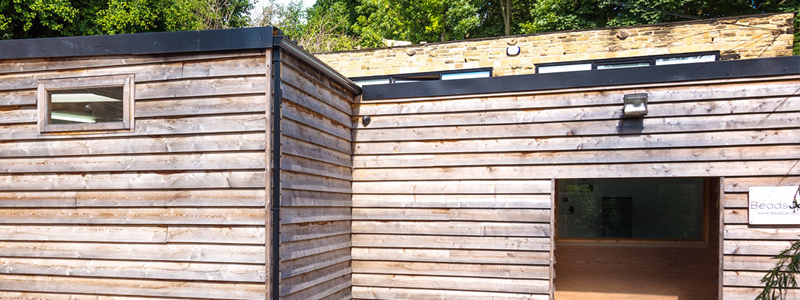Articles: Canadian Cedar Cladding Alternatives
Canadian Western Red Cedar Cladding, one of the most sought after and aesthetic looking pieces of timber money can buy. With its light brown base enriched with hues of orange through to purple, its stunning variety is one of its greatest attractions and can be used in a variety of applications, the most common of which is as external and internal timber cladding.
 Here is an image kindly sent in to us from an iWood customer representing the spectacular appearance of Canadian Western Red Cedar.
Here is an image kindly sent in to us from an iWood customer representing the spectacular appearance of Canadian Western Red Cedar.
Canadian Cedar demand
However, as you might expect, Canadian Cedar isn’t always available for purchase due to its high demand so I’ve produced this article to outline various alternatives, all of which have just as many advantages and tantalizing aesthetics that the highly desirable Canadian Cedar has.
British Western Red Cedar
The most popular substitute is the home grown variety of cedar, British Western Red Cedar. It’s actually not uncommon for people to opt for British Cedar over Canadian Cedar as British Cedar has a whole host of benefits of its own.
One of such sought after benefits is it’s colour uniformity, British cedar has significantly less variation in its colour than its Canadian counterpart and displays a distinctive knotty appearance which, adds to its character and charm. Furthermore, alongside its striking appearance British Cedar is grown and harvested on British soil removing the inclusion of import costs and bringing its prices down, this allows us to offer a very competitive price compared to its international relatives.
 British Cedar also has excellent longevity and will hold its own against the elements for up to 20 years plus. Moreover it’s mostly maintenance free and it can be left untreated which overtime will cause the British cedar to develop an elegant silvery-grey colour as a result of UV bleaching.
British Cedar also has excellent longevity and will hold its own against the elements for up to 20 years plus. Moreover it’s mostly maintenance free and it can be left untreated which overtime will cause the British cedar to develop an elegant silvery-grey colour as a result of UV bleaching.
Siberian Larch cladding
is the next competitor on this list and one of it’s most defining features is its affordability which is unrivalled by other cladding options, impressively it’s quality doesn’t reflect this low cost and Siberian Larch can look stunning in a variety of profiles as shown in this image below.
Siberian Larch originates from Yenisei valley which is located east of Siberia close to the Finnish border, conditions here are harsh and as a result the Siberian Larch has adapted to become one of the strongest softwood’s on the market with a natural resilience to conditions such as frost and snow. This makes it an ideal choice for external projects.

Oak Cladding
Oak is the last timber I want to discuss and it’s what iWood is most renowned for. In terms of its usage its as flexible a building material as it is durable and has seen use in the construction industry for over a century. Not only is it used as the foundations of a variety of structures it is also popularly used as cladding and can give a refined distinguished look to all manner of external buildings.
Something to consider when cladding with oak is its behaviour based on moisture content. Throughout the seasons these levels will fluctuate causing the cladding to expand and shrink, whilst completely natural and expected, it does mean you have to treat it on all four sides and both ends when kiln dried to seal it, if you follow our affiliate link you can find the company we recommend for any wood treatment.
This helps prevent moisture being absorbed and minimizes movement of the wood if you follow our affiliate link you can find the company we recommend for any wood treatment.
Naturally, oak cladding will develop cracks and splits as it ages which will not affect the structural integrity of the wood but will give the timber a rustic and traditional look which a lot of customers find highly appealing.








 Main Menu
Main Menu

